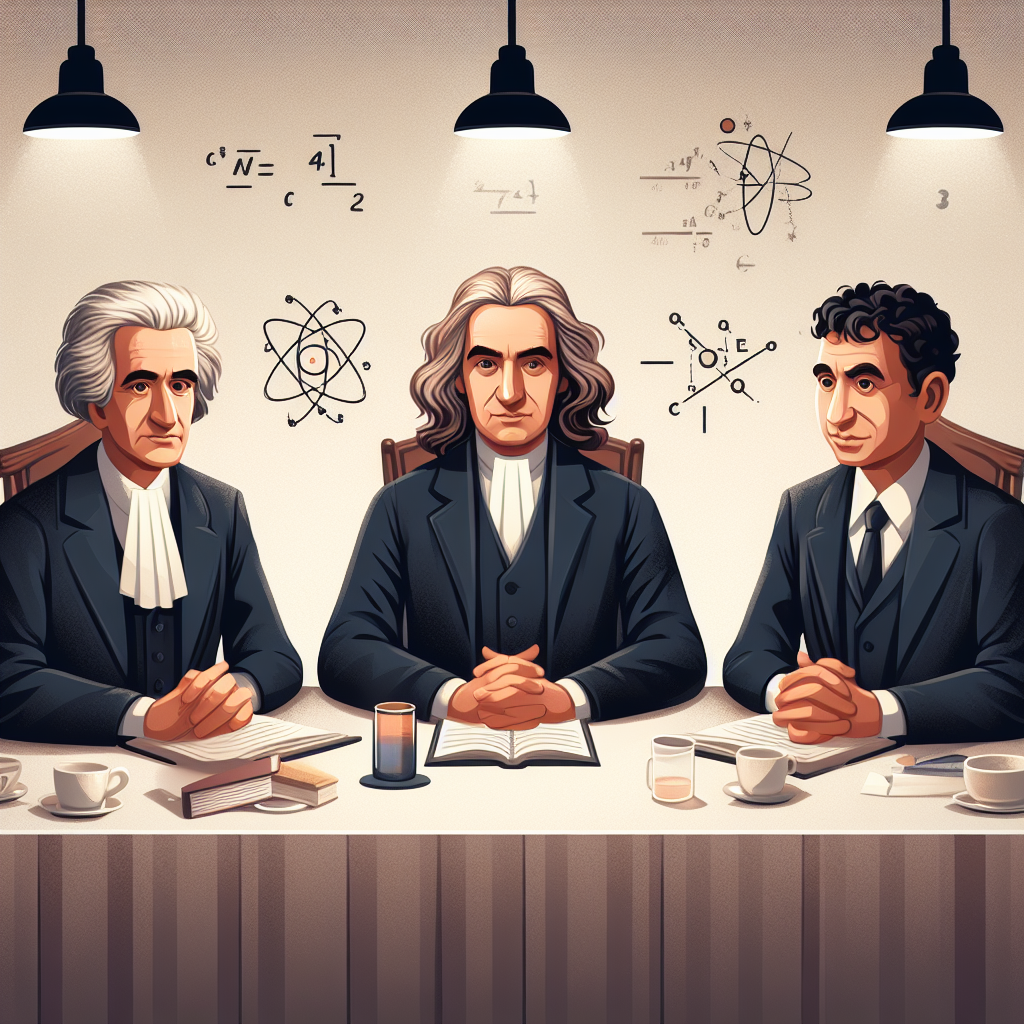Introduction:
The quest to understand the fundamental nature of the universe has been a timeless pursuit that has captivated the minds of brilliant thinkers throughout history. From the classical mechanics of Newton to the revolutionary theories of Einstein and the enigmatic realm of quantum mechanics, the landscape of physics has continually evolved. In this post, we will delve into the fascinating worlds of quantum mechanics, string theory, and the contributions of three iconic physicists: Newton, Einstein, and Feynman.

Newtonian Mechanics: The Foundation of Classical Physics
Sir Isaac Newton, a towering figure in the history of physics, laid the groundwork for classical mechanics with his laws of motion and the law of universal gravitation. Newton’s deterministic worldview portrayed the universe as a clockwork mechanism, where the motion of every particle could be precisely predicted given its initial conditions.
For centuries, Newtonian mechanics provided an accurate description of the macroscopic world, successfully explaining the motion of planets, the behavior of projectiles, and the dynamics of everyday objects. However, as the 20th century dawned, cracks began to appear in this seemingly unassailable framework.
The most famous Newtonian law that everyone can recall are the three laws of motion stated below.
- First Law of Motion: The law of inertia states that an object at rest will remain at rest, and an object in motion will continue moving with a constant velocity, unless acted upon by an external force.
- Second Law of Motion: This law relates the force acting on an object to its mass and acceleration.
- Third Law of Motion: The magnitude of action reaction pair forces is equal, the direction of forces is opposite of each other, and the pair of forces should act on two different bodies but not on the same bodies.
The less commonly known to most people is the discovery of calculus by Sir Issac Newton. The discovery of calculus enables us (and Newton) to calculate the orbits of celestrial objects in the (night) sky and his famous quote – “Does the moon also fall?”
Einstein’s Revolution: Relativity and the Warping of Spacetime
Albert Einstein, a name synonymous with genius, shattered the Newtonian paradigm with his groundbreaking theories of relativity. Special relativity, formulated in 1905, revealed that time and space are interconnected, and the speed of light is a universal constant. General relativity, introduced in 1915, extended these ideas to incorporate gravity by positing that massive objects warp the fabric of spacetime. Everyone can recite his famous fomula that states E=mc². The formula that states conversion of energy from mass of a object with speed of light, a universal constant.
Einstein’s theories not only provided more accurate descriptions of phenomena at high speeds and in strong gravitational fields but also introduced a new perspective on the nature of reality itself. The concept of spacetime as a dynamic, flexible entity challenged our intuitive understanding of the universe.
Quantum Mechanics: The Bizarre World of the Microscopic
While Einstein was reshaping our understanding of the cosmos, a parallel revolution was taking place at the microscopic level with the advent of quantum mechanics. Pioneered by luminaries such as Max Planck, Niels Bohr, and Erwin Schrödinger, quantum mechanics unveiled a surreal world where particles could exist in multiple states simultaneously and could exhibit wave-particle duality.
Quantum mechanics introduced uncertainty and probability into the heart of physics, challenging the determinism of classical mechanics. The famous Heisenberg Uncertainty Principle asserted that certain pairs of properties, like position and momentum, could not be precisely known simultaneously. This marked a departure from Newtonian predictability and paved the way for a new era of exploration.
String Theory: Harmony in the Symphony of the Cosmos
As physicists grappled with the dual nature of particles and the mysteries of the quantum realm, another ambitious theory emerged to unify the fundamental forces of nature: string theory. Developed in the mid-20th century, string theory posits that the fundamental building blocks of the universe are not particles but tiny, vibrating strings.
String theory seeks to harmonize quantum mechanics and general relativity, providing a unified framework for understanding the forces that govern the cosmos. By postulating the existence of multiple dimensions and revealing the interconnectedness of seemingly disparate phenomena, string theory offers a tantalizing glimpse into a deeper, more comprehensive understanding of the universe.
Feynman’s Quantum Dance: The Path to Understanding
Richard Feynman, a Nobel laureate known for his exceptional ability to communicate complex ideas, made significant contributions to quantum mechanics. His diagrams, now known as Feynman diagrams, offered a visual language to understand particle interactions and played a crucial role in the development of quantum electrodynamics (QED).
Feynman’s unique approach, blending mathematical rigor with intuitive insight, continues to inspire physicists and science enthusiasts alike. His lectures, accessible yet profound, underscored the beauty and elegance inherent in the laws of physics.
Conclusion:
In the grand tapestry of physics, the journey through quantum mechanics, string theory, and the legacies of Newton, Einstein, and Feynman invites us to contemplate the intricate dance of the cosmos. From the deterministic precision of Newtonian mechanics to the mind-boggling uncertainty of quantum realms and the harmonious vibrations of string theory, the story of physics is a testament to the ever-unfolding nature of our understanding.
As we stand at the threshold of the unknown, the contributions of these iconic physicists serve as guiding lights, urging us to embrace the uncharted territories of knowledge. Newton, with his laws, laid the cornerstone; Einstein, with relativity, reshaped our cosmic perspective; Feynman, with his quantum dance, illuminated the intricacies of the microscopic world.
The beauty of the pursuit lies not only in the answers we uncover but also in the questions that propel us forward. The cosmos, with its enigmas and complexities, beckons us to explore, to marvel, and to revel in the profound mysteries that continue to shape the very fabric of our reality. In this perpetual quest for understanding, we find not only the elegance of equations and theories but also the boundless wonder that fuels the human spirit’s eternal curiosity.